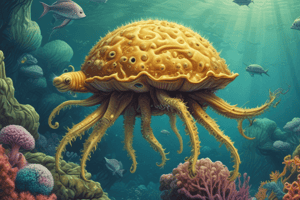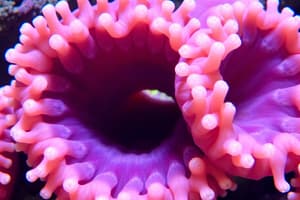Podcast
Questions and Answers
Sponge larvae possibly use a protein called ______ for phototaxis.
Sponge larvae possibly use a protein called ______ for phototaxis.
crypto-chrome
In July 2015, researchers collected sponge larvae from local reefs in ______ to study their light-sensing abilities.
In July 2015, researchers collected sponge larvae from local reefs in ______ to study their light-sensing abilities.
Florida
Scientists are conducting genetic, physiological, and behavioral tests to determine if ______ is the light receptor in sponges.
Scientists are conducting genetic, physiological, and behavioral tests to determine if ______ is the light receptor in sponges.
crypto-chrome
Recent genetic research suggests that ______ (comb jellies) might be an older lineage.
Recent genetic research suggests that ______ (comb jellies) might be an older lineage.
Further research is needed to understand the evolutionary relationships between sponges, ctenophores, and other animals, with ongoing debates and the need to analyze vast amounts of data for ______.
Further research is needed to understand the evolutionary relationships between sponges, ctenophores, and other animals, with ongoing debates and the need to analyze vast amounts of data for ______.
Sponges come in various colors, shapes, and sizes, with over 8,500 known species found in oceans worldwide, including both tropical and ______ regions.
Sponges come in various colors, shapes, and sizes, with over 8,500 known species found in oceans worldwide, including both tropical and ______ regions.
Sponges are ______ animals lacking specialized tissues like a heart or brain, but they do have differentiated cells and their skeletons are made of silica or calcium carbonate.
Sponges are ______ animals lacking specialized tissues like a heart or brain, but they do have differentiated cells and their skeletons are made of silica or calcium carbonate.
Sponges have been found to produce bioactive compounds with medicinal uses, including the development of drugs for viral infections, infectious diseases, and ______.
Sponges have been found to produce bioactive compounds with medicinal uses, including the development of drugs for viral infections, infectious diseases, and ______.
Sponges play a crucial role on reefs by providing habitat for other animals, acting as food for some predators, and creating a three-dimensional ______.
Sponges play a crucial role on reefs by providing habitat for other animals, acting as food for some predators, and creating a three-dimensional ______.
Sponges are filter feeders that rely on microbial symbionts for survival, with certain sponge species having microbial cells making up over 50% of their ______.
Sponges are filter feeders that rely on microbial symbionts for survival, with certain sponge species having microbial cells making up over 50% of their ______.
Flashcards are hidden until you start studying
Study Notes
- Sponges come in various colors, shapes, and sizes, with over 8,500 known species found in oceans worldwide, including both tropical and arctic regions.
- Sponges are primitive animals lacking specialized tissues like a heart or brain, but they do have differentiated cells and their skeletons are made of silica or calcium carbonate.
- Sponges have been found to produce bioactive compounds with medicinal uses, including the development of drugs for viral infections, infectious diseases, and cancers.
- Sponges play a crucial role on reefs by providing habitat for other animals, acting as food for some predators, and creating a three-dimensional topography.
- Sponges are filter feeders that rely on microbial symbionts for survival, with certain sponge species having microbial cells making up over 50% of their body.
- Research is being conducted on sponge microbiomes and genomes to understand how environmental factors and human populations can impact microbial communities associated with sponges.
- The sponge industry is still active in places like Red Bays, Andros Island, with three commercially viable sponge species – hard head, wool, and grass sponges – being harvested and sold globally.- Sponges are back in the fishing industry on Andros Island in the early 60s, with local spongers taking pride in their work and quality products.
- Sponge larvae move around during their larval stage and possibly use a protein called crypto-chrome for phototaxis, allowing them to sense light direction.
- In July 2015, researchers collected sponge larvae from local reefs in Florida to study their light-sensing abilities and the presence of crypto-chrome.
- Scientists are conducting genetic, physiological, and behavioral tests to determine if crypto-chrome is the light receptor in sponges.
- Traditionally, sponges were believed to be the first animals to branch off the Animal Tree of Life, but recent genetic research suggests that ctenophores (comb jellies) might be an older lineage.
- If ctenophores branched off first, it challenges long-held theories about the evolution of animal traits, such as the development of nervous systems.
- Further research is needed to understand the evolutionary relationships between sponges, ctenophores, and other animals, with ongoing debates and the need to analyze vast amounts of data for clarity.
Studying That Suits You
Use AI to generate personalized quizzes and flashcards to suit your learning preferences.




